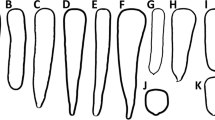Summary
Isozyme analysis of wild and domesticated accessions indicated that domestication of the cultivated carrot Daucus carota ssp. sativus resulted in an insignificant reduction of all genetic variability and genetic distance estimates. Although they are less variable genetically, cultivated forms maintain a high proportion of observed heterozygosity. Relative to the overall genetic variability of the species, samples from four common cultivars ‘Red Cored Chantenay’, ‘Scarlet Nantes’, ‘Danvers Half Long’ and ‘A Plus’ demonstrated a high degree of genetic similarity. This is attributed to the recent development of orange cultivars and the limited gene pool utilized in their development.
Similar content being viewed by others
References
Arus P (1983) Genetic purity of commercial seed lots. In: Tanksley SD, Orton TJ (eds) Isozymes in plant genetics and breeding. Elsevier, Amsterdam, pp 415–423
Babb MF, Kraus JE, Magruder R (1950) Synonymy of orange fleshed varieties of carrots. Circular no. 833, US Dept Agric, Washington, D.C.
Banga O (1976) Carrot. In: Simmonds NW (ed) evolution of crop plants. Longman, London, pp 291–293
Bayer RJ, Crawford DJ (1986) Allozyme divergence among five diploid species of Antennaria (Asteraceae:Inuleae) and their allopolyploid derivatives. Am J Bot 73:287–296
Brown ADH (1978) Isozymes, plant population genetic structure and genetic conservation. Theor Appl Genet 52:145–157
Brown ADH (1979) Enzyme polymorphism in plant populations. Theor Popul Biol 15:1–42
Cardy BJ, Stuber CW, Goodman MM (1981) Techniques for starch gel electrophoresis of enzymes from maize (Zea mays L.). Institute of Statistics mimeograph ser no. 1317. North Carolina State University, Raleigh
Ellstrand NC, Marshall DL (1985) The impact of domestication on distribution of allozyme variation within and among cultivars of radish, Raphanus sativus L. Theor Appl Genet 69:393–398
Gottlieb LD (1981) Electrophoretic evidence and plant populations. Prog Phytochem 7:1–46
Goff ES (1880) Sixth annual report of the board of control of the New York Experimental Station. Troy Press, New York, pp 133–147
Hamrick JL, Linhart YB, Mitton JB (1979) Relationships between life history characteristics and electrophoretically detectable genetic variation in plants. Annu Rev Syst Ecol 10:173–200
Helweg L (1908) A monograph of cultivated carrot varieties and a contribution to the historical study of their cultivation (in Swedish). Tidsskr Landbrugets Planteavl 15:417–453
Levin DA (1976) Consequences of long term artificial selection, inbreeding and isolation in Phlox. 2. The organization of allozymic variability. Evolution 30:463–472
Magruder R, Boswell VR, Ensweller SL, Miller JC, Hutchins AE, Wood JF, Parker MM, Zimmerley HH (1940) Description of types of principle American varieties of orange fleshed carrots. USDA publ no 361. Washington, D.C.
Nei M (1972) Analysis of gene diversity in subdivided populations. Proc Natl Acad Sci USA 70:3321–3323
Nei M (1973) Genetic distances between populations. Am Nat 106:283–292
Rohlf FJ, Kishpaugh J, Kirk D (1974) Numerical taxonomy system of multivariate statistical programs. State University of New York, Stoney Brook
Sneath PHA, Sokal RR (1973) Numerical taxonomy. F. H. Freeman, San Fransisco
Soltis DE, Haufler CH, Darrow DC, Gastony GJ (1983) Starch gel electrophoresis of ferns: a compilation of grinding buffers, gel and electrode buffers, and staining schedules. Am Fern J 73:9–27
St. Pierre MD (1989) An electrophoretic survey of the genetic variability within the Daucus carota complex (Apiaceae: Caucalideae) M.Sc. thesis, University of Windsor, Ontario
St. Pierre MD, Bayer RJ, Weis IM (1990) An isozyme-based assessment of the genetic variability within the Daucus carota L. complex (Apiaceae: Caucalideae) Can J Bot 68:2449–2457
Suurs LCJM (1986) Routine large-scale electrophoresis for plant breeding. An example with F1 seeds of brussels sprouts (Brassica oleracea var gemmifera'). Euphytica 36:147–151
Tanksley SD, Orton TJ (1983) Isozymes in plant genetics and breeding, parts A & B. Elsevier, Amsterdam
Vilmorin-Andrieux MM (1885) Carrot. In: Robinson W (ed) Vegetable garden (English edn). John Murray, London, pp 159–170
Whitkus R (1985) FORTRAN program for computing genetic statistics from allelic frequency data. J Hered 76:142
Wijnheimer EHM, Brandenburg WA, Ter Borg SJ (1989) Interactions between wild and cultivated carrots (Daucus carota L.) in the Netherlands. Euphytica 40:147–154
Wilkinson L (1988) SY STAT; the system for statistics. SY STAT, Evarston, Ill.
Author information
Authors and Affiliations
Additional information
Communicated by A. R. Hallauer
Rights and permissions
About this article
Cite this article
St. Pierre, M.D., Bayer, R.J. The impact of domestication on the genetic variability in the orange carrot, cultivated Daucus carota ssp. sativus and the genetic homogeneity of various cultivars. Theoret. Appl. Genetics 82, 249–253 (1991). https://doi.org/10.1007/BF00226221
Received:
Accepted:
Issue Date:
DOI: https://doi.org/10.1007/BF00226221




